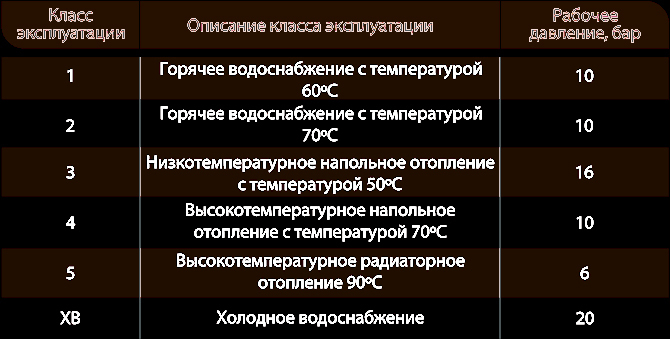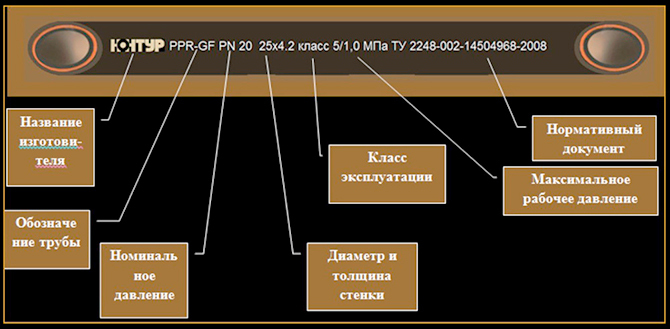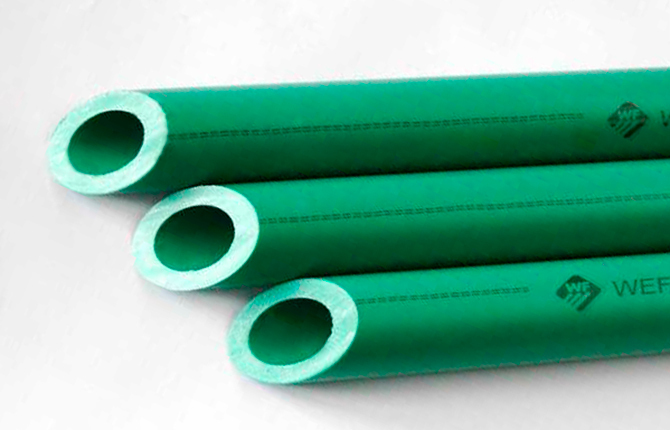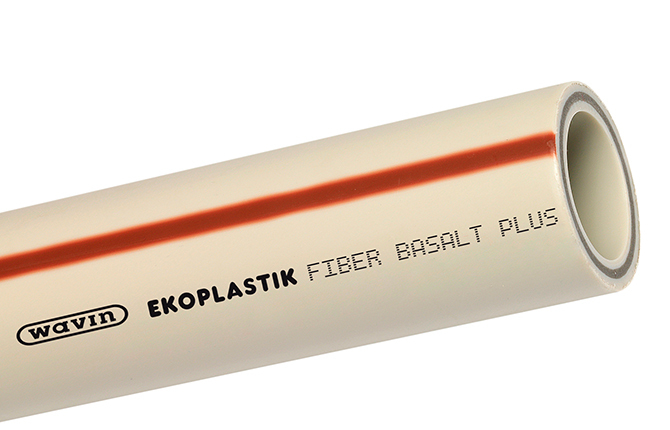Thermoplastic pipes, especially of the pressure type, have practically replaced metal pipelines. And the point here is not only the low price of plastic and the simplicity of the installation process. Thermoplastic pipes meet the requirements of GOST and SNiPs of pipeline facilities, as well as operating conditions.
The content of the article:
-
General information
- Varieties of material
- Special properties of polypropylene pipes
- Scope of pipe rolling
- Rated temperature and scope
-
Details
- Characterization of physical properties
- Reinforcement types
- Pipe pressure specifications
- Color characteristic
- Famous pipe brands
- How to choose a product
General information
All types of plastic pipes belong to the category of thermoplastic pipes. These are polypropylene, polyethylene (cross-linked, including), polyvinyl chloride and polybutene. All products are manufactured in accordance with GOST. Its number is 521343-2003. The technical characteristics of the materials are also indicated here.
Varieties of material
In the above-mentioned legislative document, polypropylene pipes are represented by three positions with different technical characteristics:
- Polypropylene homopolymer marked PP-H or PP of the first type, PP-G.
- Polypropylene block copolymer - PP-B. Russian marking - PP of the second type or PP-B.
- Polypropylene random copolymer - PP-R. Russian marking - PP of the third type or PP-R.
The latter material is considered a breakthrough in the creation of pipelines for various purposes. Therefore, PP-R is most often used in the production of polypropylene pipes.
All polypropylene structures up to 180 mm in diameter are produced in coils. Above this size - in straight lines.
Special properties of polypropylene pipes
The advantages of this material:
- increased strength, the ability to withstand high pressure of the medium that moves along the line;
- polypropylene is environmentally friendly - when heated and at high humidity, it does not emit toxic substances;
- has a low coefficient of thermal conductivity, which is important when it comes to propylene pipes for hot water;
- service life - at least 50 years;
- low specific gravity, which simplifies unloading and loading, transportation, movement, storage and connection of sites with each other.
Scope of pipe rolling
The list where polypropylene pipes are used is wide. These are practically all types of human life, including the household sector, industrial and agriculture. For example;
- plumbing: cold and hot;
- heating systemincluding warm floors;
- ventilation;
- drainage;
- irrigation systems;
- pipelines with aggressive media;
- lines that pump air under pressure.
Rated temperature and scope
In the technical characteristics of polypropylene pipes there is an indicator of reliability, which depends on the temperature of the medium flowing inside the pipeline. According to this characteristic, pipes are divided into five classes. And all of the above designated types, and this is PP-H, PP-R, PP-B, are included in them.
They can withstand temperatures up to + 80 ° C, depending on their belonging to one class or another.

Technical characteristics of reliability
In the marking of a polypropylene pipe, this technical characteristic is indicated - the class of the product is written on the wall. It will be written - class 5, as shown in the picture below.

Class marking
According to GOST, the service life of a polypropylene pipeline is determined by the total operating time at high temperatures. Where the maximum value is 50 years.
Some manufacturers are trying to use the latest technologies that allow them to produce materials with higher temperature parameters. In this regard, there are no restrictions. But the labeling will still indicate "class 5" as the maximum technical specification in accordance with GOST.
All polypropylene pipes from the classification can be used on lines with cold water, the pressure of which should not exceed 1 MPa.
Details
Let's move on to the technical specifications. One was mentioned above - this is the temperature. But there is also an equally important one - pressure.
Characterization of physical properties
Polypropylene has a low density - 0.91 kg / cm². But at the same time, this material is very durable, hence the high wear resistance. The smooth surface (external and internal) determines the quality of the plastic product. For example, in the same GOST it is written:
- The surfaces (external and internal) should be as smooth as possible. Slight waviness is allowed - this also applies to longitudinal stripes. The main thing is that the wall thickness of the polypropylene pipe does not exceed or be less than the permissible dimensions.
- During the production process, bubbles, pores, cracks and foreign inclusions must not be allowed to appear on the surface. This also applies to the ends.
- The color must be uniform. It is indicated in the certificate.
Additional technical characteristics that relate to the operating temperature:
- at a temperature of + 140 ° C, polypropylene begins to soften;
- at + 170 ° С it melts;
- withstands the temperature of the pumped medium - up to + 90 ° С.
Polypropylene pipes must be tested. To do this, water is driven inside them with a temperature of up to + 110 ° C.
Reinforcement types
Polypropylene pipes, like many other plastic pipes, have a drawback. When hot water passes through them, their longitudinal expansion is equal to 15 mm / m. Experts solved this problem quickly by putting it inside the wall of the product reinforcing frame.
There are four reinforcement technologies:
- A solid sheet of aluminum is used. It can be laid in one of three parts of the wall: closer to the outer surface, closer to the inner, in the middle.
- The same aluminum sheet is used, only with perforations. Its strength is lower, so the laying is carried out closer to the outer surface.
- Fiberglass. During the production of polyethylene pipes, it is laid in the middle of the wall.
- Material composed of fiberglass and polypropylene.
The last two positions are better than the first two. It's all about the aluminum itself. Under the influence of salts that are present in hot water, it begins to corrode - the quality of the pipe joints decreases. Indeed, when joining, the ends of the pipes are cleaned to the reinforcing frame. And even with high-quality soldering, capillaries remain, through which water reaches the reinforcing cage.
Reinforcement reduces linear expansion by a factor of five.

Reinforcement with perforated aluminum sheet
Pipe pressure specifications
The second important characteristic after temperature is pressure. It directly depends on the wall thickness. The larger the latter, the more pressure the polypropylene pipe can withstand. In the marking, this technical characteristic is also indicated, and it is designated by two Latin letters - “PN”.
Today manufacturers offer four positions for this technical characteristic:
- It is used in water mains that carry cold water. Designation - PN10. The pipeline can withstand 1.0 MPa or 10 atm.
- The product of the second class can already withstand 1.6 MPa. Such pipes are usually laid in low-temperature heating systems, such as underfloor heating, where the temperature of the coolant does not exceed + 60 ° C. Designation - PN16. Some hot water systems are also used.
- PN20. Withstand pressure up to 2.0 MPa. Installed in heating networks of the radiator type, where the temperature of the coolant reaches + 95 ° C. In industry, these pipes are used when it is necessary to assemble a scheme for the movement of hot water from the boiler room to the point of entry into the technological process.
- PN25. It is not used in everyday life, only at industrial facilities. Withstands loads up to 2.5 MPa and temperatures up to + 110 ° С.
Color characteristic
PP pipe color does not affect product performance. But manufacturers specially paint the manufactured products with the expectation that this will help to choose them correctly, taking into account the scope of application.
White pipes are usually purchased when you need to build a water supply network. But they do not withstand low temperatures well. Therefore, they try not to lay them on the street or carry out insulation.
Gray ones are purchased for heating systems, but they are often used for arranging the water supply system. They are chemically and thermally stable, keep temperature well.
Black ones are used in the arrangement of drainage systems, but they are often used in street water supply. Their feature is that they can withstand the negative effects of sunlight well. Therefore, they feel great when used outdoors in the open air.
Green pipes are polypropylene pipes that manufacturers recommend using to create an irrigation system. The technical characteristics of the products do not meet the requirements of GOST. But more recently, manufacturers have begun to pay great attention to the technical side of the matter. Therefore, green polypropylene products are also recommended for the organization of water supply networks.

Green polypropylene pipes
Famous pipe brands
Technical characteristics are the main criterion according to which it is necessary choose polypropylene pipes. But the Russian building materials market was filled not only with branded products. 50% are brands unknown to anyone with incomprehensible technical characteristics. Therefore, it is important to pay attention to the manufacturer when choosing. Here are the top 10 popular brands.
In tenth place is the English brand "Blue Ocean", whose products are manufactured in China. Not the worst Chinese material - it is not in vain that many European countries have certified it. The catalog contains both standard polypropylene pipes and reinforced ones (fiberglass and aluminum).
The ninth place belongs to the Russian brand “Pro Aqua”. These polypropylene pipes cannot compete with European counterparts. But the Chinese and Turkish, they are serious competition due to environmental friendliness and good technical characteristics. For example, pipe products of this company can withstand short-term pressure up to 7.0 MPa.
The eighth place was given to the Turkish company "Tebo". And although the products belong to the category of economy class, their technical characteristics are quite good. The manufacturer offers pipes with a diameter of 20-160 mm and fittings for them. They are all reinforced with either aluminum or fiberglass. The catalog contains classes PN10, 20 and 25.
The Turkish company "Pilza" is ranked seventh. Here the price and technical characteristics are in an optimal ratio.
The next place (sixth) is given to the joint venture, where the participants are Russia and Italy. This is the “Valtec” brand. It is one of the most popular brands in Russia.
In fifth place is the Romanian brand “SupraTherm”. The brand has been known in Europe since 1990. In Russia, its pipes are still in short supply. Attractive price, plus almost German quality. Has all European certificates.
Czech polypropylene pipes of the Wavin Ekoplastik brand are in fourth place. Today it is the most famous brand in the catalog of which products are reinforced with basalt. The quality is not inferior to German.

Basalt Reinforced Pipe
All three prizes are taken by polypropylene pipes made in Germany:
- the third line of the rating is occupied by the company “Wefatherm”;
- the second "Aquatherm";
- the first "Banninger".
How to choose a product
Many are looking for inexpensive polypropylene pipes, but with good technical performance. And it is right. It is not difficult to find such analogs on the market today. The main thing is to choose according to the operating conditions.
Recommendations:
- Purchase reinforced products for hot water supply and heating.
- In private houses, it is better to use products with a technical indicator PN20. In city apartments - PN25. This is due to the fact that the heat carrier pressure is high in the heating system of city houses.
- The temperature indicator in the certificates and markings of many manufacturers differs from the normative one (according to GOST). This does not mean that the actual temperature value does not meet the standards.
Even high quality products do not guarantee trouble-free operation of the pipeline if the installation requirements have been violated. In this case, even increased technical characteristics will not help.
Did you know about all the nuances that you need to pay attention to when choosing pipes? Write in the comments. Save the article to bookmarks, share it on social networks.
The video will complement our article and answer the remaining questions.
Polypropylene pipes for heating - how to choose.
Sources:
- https://internet-law.ru/gosts/gost/8446
- https://iseptick.ru/truby-i-fitingi/polipropilenovye-truby/texnicheskie-xarakteristiki-polipropilenovyx-trub-vidy-markirovka-osobennosti-ekspluatacii.html
- https://vse-o-trubah.ru/tsveta-i-sfera-primeneniya-polipropilenovyh-trub.html#
- https://markakachestva.ru/best-brands/3165-10-luchshih-proizvoditelej-polipropilenovyh-trub.html


